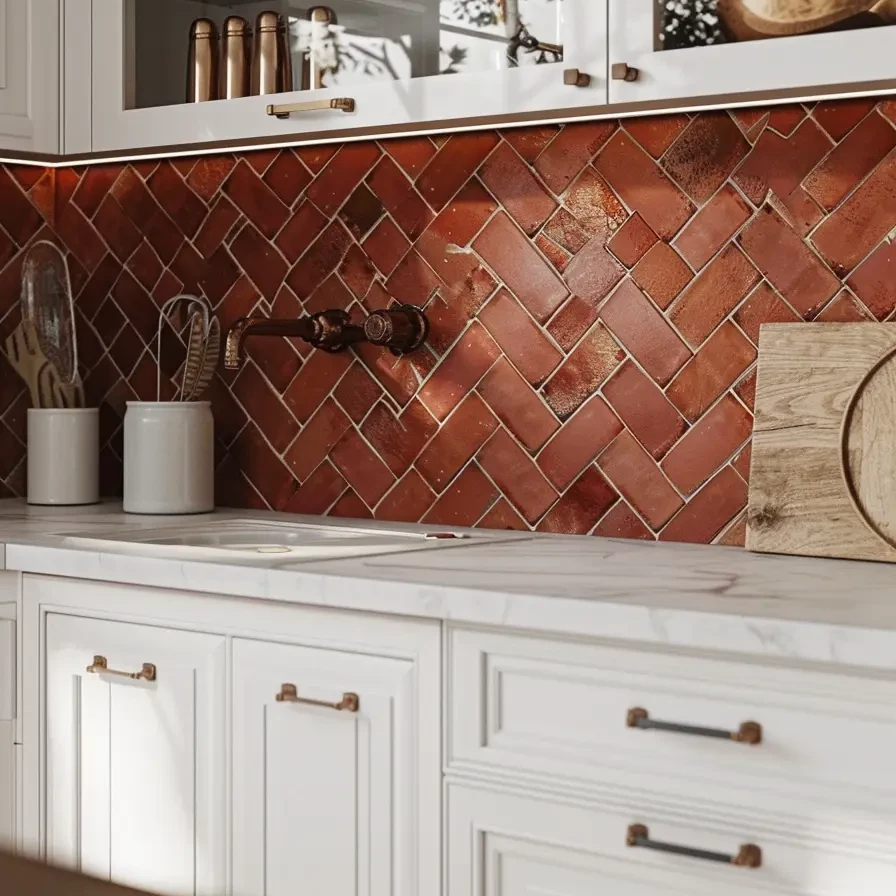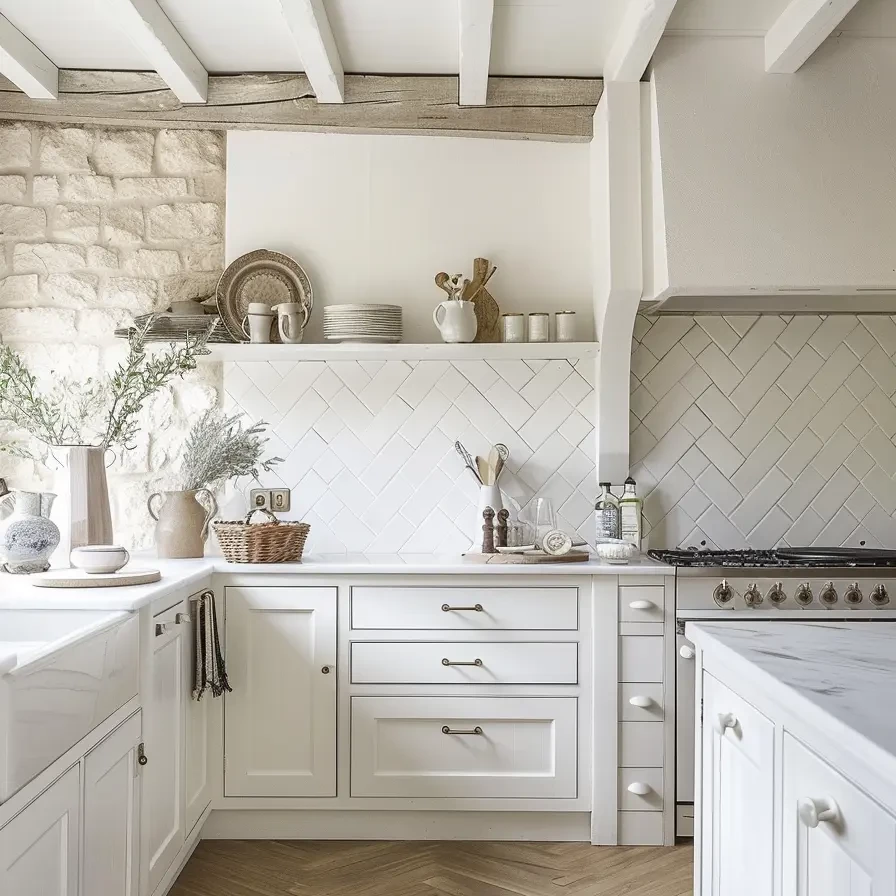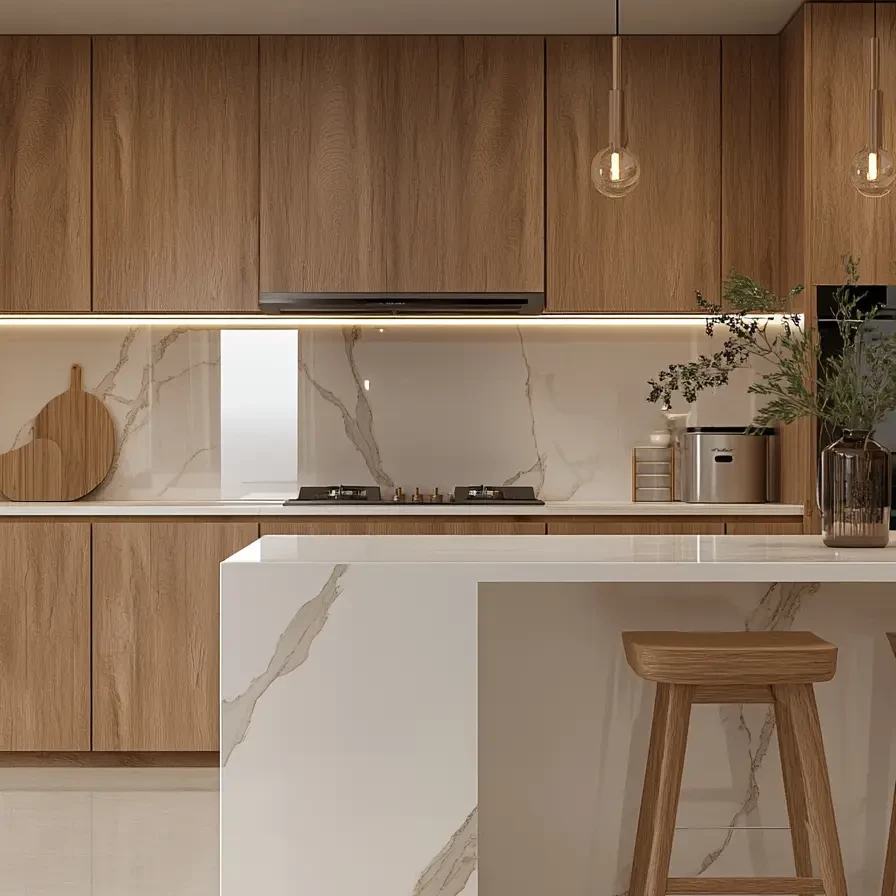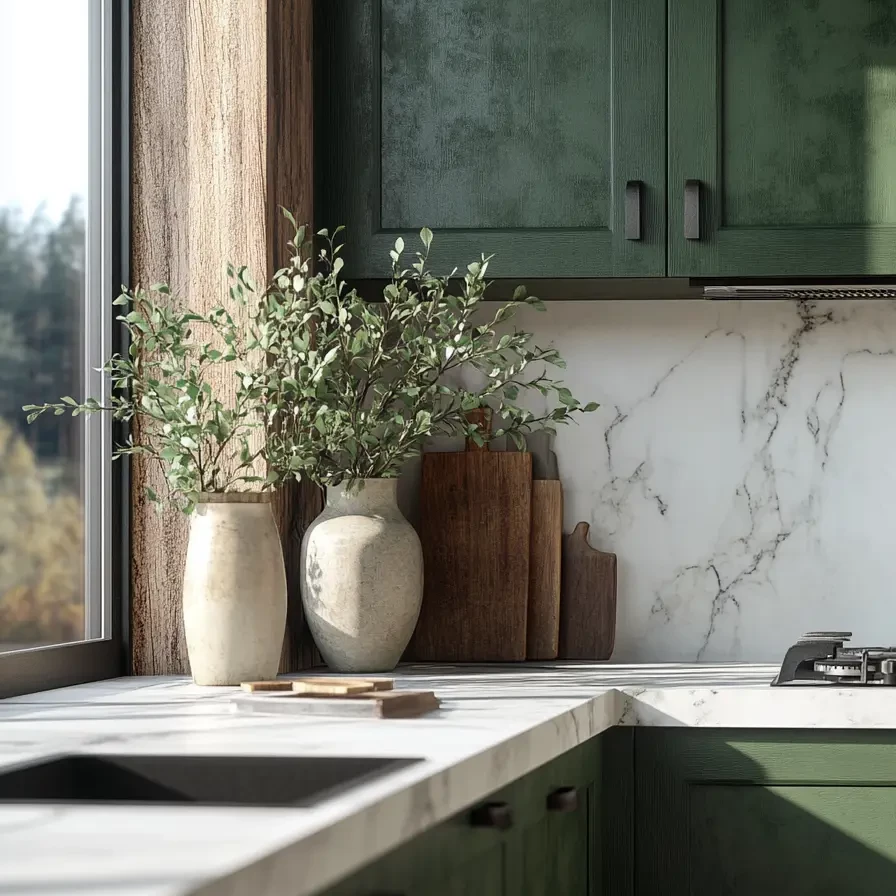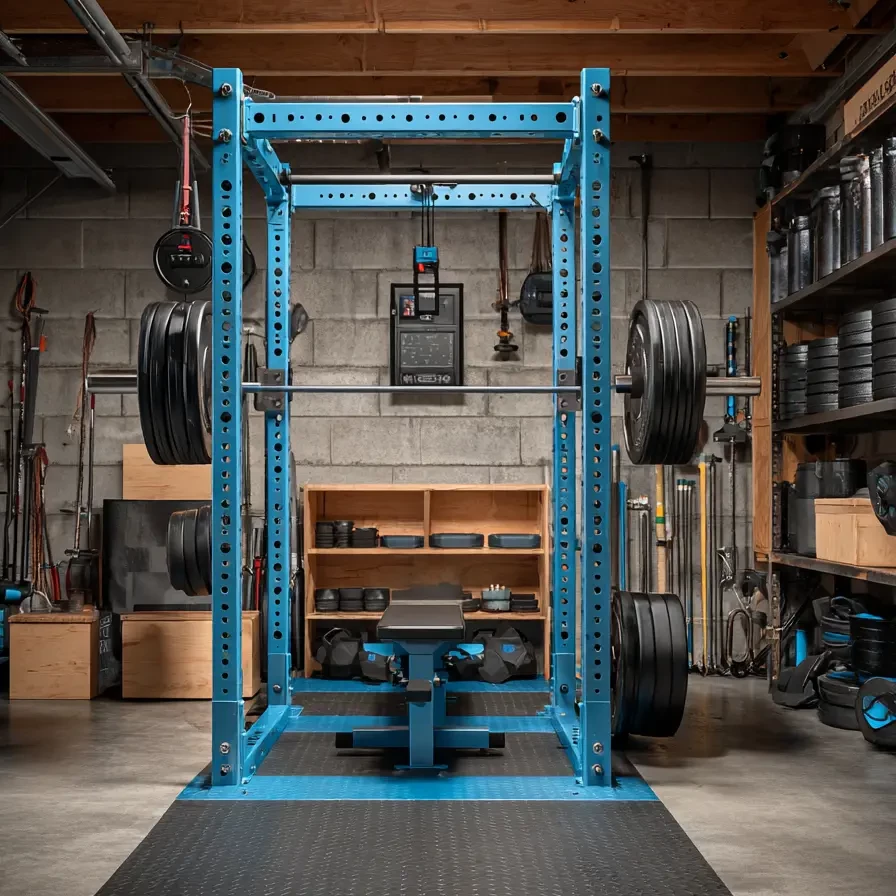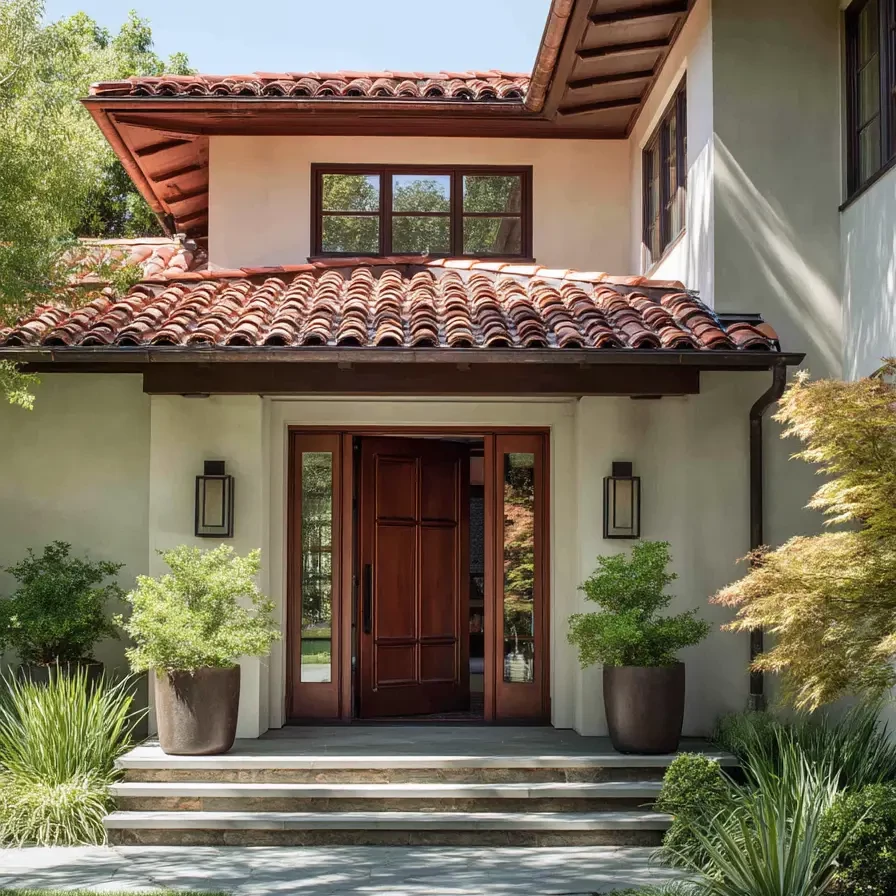Picture this: walking into a Mediterranean kitchen where the sun-kissed terracotta tiles meet the soft, whitewashed walls, and the scent of fresh herbs fills the air. Your eyes are drawn to rustic wooden beams overhead, while vibrant ceramics and woven baskets add bursts of color and texture. It’s a space that whispers stories of coastal villages, where every detail is crafted to evoke warmth and timeless elegance. Ready to discover how to transform your kitchen into a Mediterranean masterpiece? Let’s embark on this visual journey and soak up the rich tapestry of Mediterranean design together.
Harmonizing Warm Tones with Sleek Black Accents
Polished concrete floors and muted olive cabinetry set a serene, understated tone in this Mediterranean kitchen, creating a seamless blend of simplicity and sophistication. The streamlined cabinetry is adorned with minimalist hardware, which offers functionality without distracting from the calming color palette. Above the island, black minimalist pendant lights with exposed wooden accents echo the warm, earthy tones seen on the open wood shelving, which casually displays various ceramics and spices. This setup not only emphasizes utility but also introduces an organic, welcoming atmosphere ideal for gathering and culinary exploration.
Cone-Shaped Pendant Lights: Create Warmth with Inviting Ambience
Incorporate the serenity of the Mediterranean into your kitchen with taupe-colored cabinetry paired with understated creamy hues. This gentle color palette both calms and brightens the space while exemplifying minimalist chic. Complement this aesthetic with cone-shaped pendant lights that cast an inviting glow, enhancing the room's cozy ambiance. Neutral-toned, smooth marble backsplashes with minimal veining add a touch of sophistication without overpowering the subtle elegance of the cabinetry. Opt for clean-lined furniture and clutter-free surfaces to maintain an overall sense of tranquility and order, characteristic of Mediterranean interiors.
Herb Pots: A Functional Touch of Greenery
In the realm of Mediterranean kitchen design, the charm of distressed green cabinetry paired with terracotta floor tiles creates a warm, inviting atmosphere that is both rustic and refreshing. Incorporating arched ceiling alcoves and exposed wooden beams adds historical depth, suggesting a narrative woven through time. Strategic use of natural lighting through large, double doors enhances the earthy tones of the walls and highlights the handcrafted details of the cabinetry. Placing potted herbs on open wooden shelving not only brings functionality and fragrance but also infuses a touch of nature, reinforcing the Mediterranean ethos of blending the indoors with the outdoors. This approach to kitchen decor not only revitalizes traditional elements but also fosters a serene, timeless environment.
Showcase Handmade Pottery on Rustic Shelving for Warmth
In this Mediterranean kitchen, light wooden cabinetry eloquently pairs with terracotta and aged ceramic décor creating an inviting warmth reminiscent of a sun-drenched coastal retreat. The smooth, pale stone countertops contrast beautifully against the rustic texture of the open wooden shelving that proudly displays handmade pottery. Flooring crafted from large, natural stone tiles enhances the earthy, organic vibe, encouraging a sense of continuity with nature. This kitchen design thoughtfully balances simplicity with cultural depth, making it not just a cooking space but a centerpiece of everyday living.
Vibrant Backsplashes: Infusing Color with Intricate Tile Designs
The charm of a Mediterranean kitchen can be greatly enhanced by incorporating detailed, colorful backsplashes as seen in this space where intricate blue and orange tiles create a vibrant focal point. Dark, weathered wood cabinetry adds an element of rustic allure that contrasts beautifully with the bright tilework, making the room feel both cozy and inviting. For flooring, terracotta tiles in a mix of earthy tones harmonize with the natural aesthetic, reinforcing the rustic Mediterranean vibe. Combining these elements creates a kitchen that is not only functional but also a testament to the rich cultural heritage of Mediterranean design.
Elevate Your Space with Earthy-Toned Pottery Accents
In a sublime orchestration of natural elements, this Mediterranean kitchen features cabinetry crafted from light-toned wood, offering a serene yet inviting atmosphere. The seamless integration of wooden shelves, adorned with an array of earthy-toned pottery, complements the understated elegance of the minimalist layout. The textured plaster walls, with their soft, natural hues, enhance the organic feel, while a strategically placed vase adds a touch of vitality with subtle floral arrangement. This blend of simplicity and nature creates a calming space where culinary creativity thrives.
Crafting Rustic Elegance with Aged Wood Cabinetry and Copper Accents
In this Mediterranean kitchen, the use of aged wood cabinetry adorned with intricate carvings and distressed finishes adds a rustic charm that evokes the old-world allure. Anchoring this aesthetic is the striking copper range hood, accented with rivets, which provides a captivating focal point while blending effortlessly with the neutral color palette. The terracotta-toned floor tiles seamlessly integrate a variety of hues, creating a warm and inviting atmosphere. These elements, combined with strategically placed lighting fixtures that cast a soft glow, perfectly encapsulate the Mediterranean ethos of cozy functionality paired with timeless elegance.
Illuminate Your Space with Simple Pendant Lighting
Influenced by the serene ambiance of the Mediterranean, the kitchen uses a minimalist approach with clean, white cabinetry that provides a sleek contrast to the natural wooden elements seen in the sturdy stools and the linear grain of the plank flooring. The textured beige wall adds a touch of rustic charm, subtly complemented by ceramic accessories and dried flora that infuse soft, organic touches. Strategic lighting from simple pendant lamps casts a warm glow, highlighting the purity and simplicity of the design. This setting encourages a blend of functionality and aesthetic seamlessly, inspiring a tranquil culinary haven.
Light Wood Cabinets for an Airy and Bright Kitchen Experience
To infuse a sense of the Mediterranean into a kitchen, focus on incorporating light wood cabinetry paired with floating shelves for a breezy, open aesthetic. The use of subtle terrazzo flooring offers a playful nod to traditional Mediterranean elements while providing a durable and unique foundation. Incorporate minimalist wooden furniture with clean lines to complement the streamlined kitchen design, ensuring that the space remains airy and bright. Decorate with neutral-toned ceramics and delicate dried flowers to create a soft, inviting atmosphere that resonates with the relaxing vibe of coastal Mediterranean living.
Floating Shelves: Showcase Essentials with Sleek Simplicity
In this Mediterranean kitchen, textural intrigue is masterfully curated through the use of rough, plastered walls that evoke an old-world charm, complemented by sleek, minimalistic cabinetry that brings a modern twist. This juxtaposition ensures a kitchen that feels both timeless and contemporary. Strategic use of natural lighting amplifies the spaciousness, while sandy tones across the surfaces weave a cohesive aesthetic. Employing minimalist floating shelves not only maximizes visual space but also allows for artful displays of kitchen essentials, blending functionality with Mediterranean design sensibilities.
Rustic Open Shelving: Showcase Spices with Refined Elegance
In this Mediterranean kitchen, the use of terrazzo flooring melds beautifully with the organic curves of the archways, creating a seamless flow from one space to the next. The soft neutral palette of the cabinetry, complemented by the warmth of natural wood for the open shelving, maintains a soothing ambiance. Incorporating natural textures through elements like the aged wood shelf above the stove, where everyday spices and cooking oils are readily accessible, not only enhances functionality but also adds a touch of rustic charm. Such design choices inspire a kitchen that is both aesthetically pleasing and deeply rooted in Mediterranean traditions.
Frame Views with Soft Arches for a Tranquil Ambiance
In a Mediterranean kitchen, soft arches of the windows beautifully frame exterior views, enhancing the room's natural light that complements the light gray cabinetry. Stone flooring in subtle shades of beige and cream fosters an airy feel, while tailored marble countertops incorporate a luxurious yet functional element. Strategic placement of decorative jars and pitchers on high shelves adds a personal touch without clutter, maintaining a clean and serene ambiance. The design cleverly integrates a high-end gas range into a central island, optimizing space and functionality for gourmet cooking.
Woven Pendant Lights: Illuminate with Artisanal Elegance
Introduce tranquility and a seamless flow in your Mediterranean kitchen by opting for a soft color palette of sand and beige tones, mirroring the serene beaches of the Mediterranean coast. The use of natural stone flooring enhances the organic connection to nature, while the integration of streamlined wooden cabinetry adds both functionality and understated elegance. Strategic placement of woven pendant lights above the kitchen island not only illuminates the workspace but also adds a touch of artisanal craft, complementing the rustic yet modern aesthetic. This design approach invites lightness and calm into the heart of the home, making it a perfect space for both cooking and social gatherings.
Terracotta Accents: Infusing Warmth with Earthy Cultural Touches
This Mediterranean kitchen uses minimalistic elegance through monochromatic earth tones complemented by natural textures. The smooth plaster walls and sleek concrete counters blend seamlessly, while terracotta decorative items on open shelving add depth and cultural heritage. Strategically integrating natural woods with the countertops brings a balance, ensuring a warm, welcoming environment. Such design not only optimizes natural light but also establishes a serene, simplistic aesthetic that is both functional and breathtakingly beautiful. This kitchen proves that using few colors with various textures can create a sophisticated and cohesive look.
Bold Base Cabinets: Stand Out with Cobalt Blue Elegance
In this Mediterranean kitchen, the mix of natural textures and colors plays a key role in achieving a harmonious balance. The cobalt blue base cabinets are a standout, providing a deep, vibrant contrast to the earthy tones of the terracotta floor tiles. The incorporation of a solid, natural wood countertop adds a rustic, yet luxurious touch, complementing the detailed tile backsplash that captures the essence of Mediterranean style. Exposed wooden beams and metal sconce lighting further refine the ambiance, marrying functionality with old-world charm, which is essential in crafting a genuine Mediterranean kitchen aesthetic.
Ornate Wooden Cabinets: Crafting Elegance with Intricate Detail
Envision embellishing your Mediterranean kitchen with ornately carved wooden cabinetry, offering both functionality and a visual feast. Integrating detailed tilework around the chef's area not only protects your walls but also injects a splash of deep ocean blue, echoing the serenity of the Mediterranean Sea. To complete the ambiance, opting for stone tiles on your floor can ground the space with the earthy hues of the natural landscape, providing a sturdy yet stunning foundation that ties the interior together beautifully. Add a touch of opulence with stained glass hanging lights, casting a warm, inviting glow over your culinary creations.
Wicker Pendant Lights: Rustic Elegance Above Your Kitchen Island
In a Mediterranean kitchen, light plays an essential role in creating an inviting atmosphere. Consider the strategic use of limestone on walls and countertops to reflect sunlight, which enhances the natural brightness. Wicker pendant lights, positioned above the kitchen island, not only provide gentle illumination but also add a touch of rusticism that complements the sleek, modern lines of white cabinetry. Pairing these elements with pale wood for open shelving introduces a subtle, organic contrast, making the space feel more open and serene. The overall palette of soft whites and beiges, accented by natural materials, brings the calming essence of the Mediterranean into your home.
Sleek Stone Countertops: Marrying Durability with Stylish Simplicity
For a fresh approach to Mediterranean kitchen design, consider the integration of soft, textured walls paired with sleek stone countertops offering both aesthetic beauty and practical durability. The mellow beige and soft browns create an inviting warmth, while the clear glass pendant lights add a modern touch without overpowering the naturalistic elements. This balance creates a serene yet sophisticated environment, where wooden elements and understated metal fixtures mesh seamlessly, enhancing the organic feel. Utilize minimalist wooden bar stools to complement the light wood cabinetry, further rooting the design in simplicity and natural elegance.
Crafting Serenity with Rattan Lighting and Earthy Tones
In this Mediterranean kitchen, the use of soft arches and a muted color palette creates an oasis of calm. The textured ceiling and walls, alongside the seamless integration of monochrome hues across the space, provide a minimalistic yet warm environment. Incorporating natural materials, such as the wooden table and rattan pendant lights, adds organic character and complements the rustic aesthetics. Stone countertops and a stone basin, paired with copper fixtures, maintain an element of luxury while adhering to the earthy charm typical of Mediterranean interiors. Each design choice carefully fosters a serene and inviting ambiance ideal for both cooking and communal gatherings.
Antique-Style Handles: Infusing Vintage Elegance into Your Cabinets
In designing a Mediterranean kitchen, integrating whitewashed cabinetry provides a soft, inviting backdrop that complements the warmth of terracotta tiles. Opt for antique-style handles to add a touch of historic elegance, and consider incorporating open wall-mounted racks for hanging copper cookware, which not only serves a practical purpose but also enhances the rustic aesthetic. The use of natural wood for beams and shelving introduces an earthy, robust element, harmonizing with the ceramic accessories and pottery that populate the space, creating an authentic Mediterranean atmosphere.
Craft Cozy Atmosphere with Textured Walls and Simple Stools
Incorporate textured plaster walls and simplistic wooden stools to create harmonious warmth in a Mediterranean kitchen design. These understated wall finishes, hinting at sun-drenched coastal charms, pair seamlessly with the understated yet sophisticated wood accents in furniture. The play of natural light on the subtly textured surfaces offers a tranquil atmosphere, while subtlety in shape and material emphasizes a serene and welcoming culinary oasis. Lean into minimalistic white cabinetry and countertop spaces to conjure expansive lightness against the rustic backdrop, beautifully harmonizing modernity with rustic Mediterranean traditions.
Textured Pendant Lights: Enhance Warmth with Natural Fiber Elegance
In a Mediterranean kitchen, harness the calming palette of sandy tones and light wood finishes to create a serene culinary oasis. Utilize unadorned wooden cabinetry with vertical slat detailing to introduce texture while maintaining a minimalist charm that echoes coastal vibes. Complement this setting with smooth ivory countertops and limestone flooring for a seamless integration of natural elements. Strategic placement of textured pendant lights crafted from natural fibers enhances the organic feel and casts a warm, inviting glow throughout the space, ideal for both cooking and intimate gatherings.
Ceramic Accents: Emphasizing Subtle Elegance with Understated Designs
In a Mediterranean kitchen, harness the subtle elegance of natural tones and materials. This scene perfectly employs a monochromatic pale palette, focusing on soft beige and light wood to promote a feeling of calm and openness. Notably, simple yet sophisticated, the understated ceramic accessories on open shelving echo the rustic charm of the region's traditional crafts. Strategic use of natural light not only highlights the smooth, reflective marble countertops but also enhances the overall minimalistic aesthetic. Opt for integrated wooden cabinets with streamlined handles to maintain a fluid, uncluttered look that is both functional and visually soothing. This approach creates a serene kitchen space that speaks of timeless Mediterranean simplicity and elegance.
Handcrafted Wood Cabinets: A Blend of Tradition and Modern Utility
In the realm of Mediterranean kitchens, the soft beige tones of plastered walls and ceiling create a calming, cohesive look that enhances the natural light pouring in through large windows. Opt for handcrafted wooden cabinets with detailed paneling to add an authentic rustic charm, complemented by sleek, modern stainless steel appliances that contrast beautifully while maintaining functionality. The subtle inclusion of terracotta and ceramic decor items marries modernity with tradition, keeping the space grounded and inviting. The smooth, creamy texture of limestone flooring wraps the room in a quiet luxury, reflecting light and enhancing the open, airy feel critical in Mediterranean design.
Embrace Serenity with Polished Concrete Countertops and Floating Shelves
Infusing your Mediterranean kitchen with a seamless blend of nature and modernity begins with utilizing natural, subdued color palettes and materials. In this setting, the soft beige tones of the walls and ceiling harmonize with the rich texture of the wooden lower cabinets, creating a tranquil base that invites calmness into the heart of your home. Introduce neutrality in your countertops with materials like polished concrete, which also extend to form floating shelves and practical, integrated sinks. This not only enhances a sleek, continuous visual appeal but also maintains functionality without sacrificing style. Adding potted herbs and earth-toned pottery strategically atop counters not only brings life but also meshes utility with aesthetic charm, reinforcing an organic, inviting kitchen environment.
Cylindrical Ceramic Pendants: Define Your Space with Soft Glow
In this Mediterranean kitchen, the integration of speckled terrazzo flooring pairs brilliantly with muted green cabinetry for a refreshing yet subtle aesthetic. The combination of smooth concrete counters alongside textured walls offers a tactile experience that beckons the natural charm of coastal landscapes. Utilizing cylindrical ceramic pendant lights, the space benefits from a soft illumination that enhances the overall serene mood, while woven seating introduces a raw textual contrast that is both inviting and stylish. This decor promotes a harmonious balance between modern design elements and traditional Mediterranean warmth, ideal for a tranquil culinary retreat.
White Cabinets and Wooden Accents: A Harmonious Blend of Calm
Infuse a refreshing minimalism into your Mediterranean kitchen by incorporating pristine white cabinetry and countertops. This chromatic harmony not only amplifies the natural light but also establishes a serene atmosphere, essential for a space used daily. Complement this calm aesthetic with natural wooden elements, such as sturdy wooden stools and exposed beams, to introduce a touch of rustic charm. The subtle integration of sleek, white pendant lights further maintains the kitchen's clean and inviting ambiance, perfect for contemporary Mediterranean living.
Create Brilliance with Sleek Marble Countertops and Bright Cabinets
In a Mediterranean kitchen, integrating subtle stone textures and minimalistic but functional furniture can profoundly affect the authenticity and ambiance of the space. Opt for streamlined marble countertops paired with full-height, light-toned wooden cabinetry to maintain a bright and spacious feel. Incorporating drop pendant lights with smooth, teardrop glass enhance a modern touch while keeping the aesthetic grounded and simple. This blend of natural materials and sleek design not only invites light but perfectly captures the essence of a Mediterranean escape, making every culinary experience a serene one.
Pendant Lighting: Subtle Elegance for Focused Culinary Tasks
In this Mediterranean-inspired kitchen, the integration of simple, uncluttered lines with natural materials creates an inviting, minimalist aesthetic. Neutral, soft beige walls complement the pristine white wooden floorboards, enhancing the sense of openness and light. Contrast is subtly introduced through natural wooden stools and terrazzo countertops, offering a hint of earthy texture. The dual pendant lights, hanging by slender black wires, provide focused illumination while maintaining an understated elegance, ideal for highlighting culinary tasks without overwhelming the serene ambiance. This design approach prioritizes functionality, with clean surfaces and ample space for movement, embodying the Mediterranean ethos of simplicity and natural beauty.
Amber Glass Pendants: Capture Seaside Light for Inviting Spaces
Introducing pastel, earthy hues on walls gently mirrors the warm Mediterranean sun, creating an inviting atmosphere in any kitchen. The use of amber glass pendants brings a hint of seaside refraction, enhancing the natural light that filters beautifully through casement windows. Employing untreated wooden beams accentuates the rustic charm while maintaining a timeless elegance. Furthermore, the strategic placement of large terracotta jars, not only as décor but also as focal points, bridges traditional crafting techniques with functional modern design. Adding to this is the thoughtful alignment of cabinetry with discreet ironwork details that provide a touch of craftsmanship without overwhelming the subtler, soothing color palette.
Wicker Bar Stools: Rustic Elegance That Complements Serenity
In this Mediterranean kitchen, the soft sage green cabinetry pairs elegantly with minimalist marble backsplashes, creating a soothing palette that reflects the serene sea hues of the Mediterranean. The use of large arched windows not only draws in natural light but also magnifies the sense of openness and connection to nature. Strategic placement of simple yet sophisticated iron-framed wicker bar stools adds a rustic touch while maintaining refinement. Incorporating unobtrusive pendant lights ensures that the kitchen remains brightly lit, focusing on functionality without compromising style, subtly complementing the wooden beams overhead and enhancing the overall airy feel of the space.
Curved Ceilings: Create Flow with Graceful Arches and Tones
Incorporate curved architectural elements to instill a sense of fluidity and movement typical of Mediterranean design, enhancing the kitchen's ambiance. This kitchen uses smooth, undulating lines of the arched ceilings to provide a natural flow, complemented by neutral earth tones that echo sandy Mediterranean landscapes. Utilizing light wooden cabinetry further emphasizes a relaxed and inviting atmosphere, while built-in shelving offers a decorative and functional element, displaying terracotta pots and artisanal pieces that bring authenticity and rustic charm to the space. By focusing on harmonious shapes and soothing color palettes, the Mediterranean style promotes a tranquil culinary oasis.
Harmonize Your Space with Vertical Lines and Earthy Hues
In the realm of Mediterranean kitchen design, subtle plays of light and shadow are crucial, much as shown in this kitchen setting with its large windows allowing natural light to wash over the soft beige walls and gray cabinetry. The clever placement of slim, tall windows accentuates the vertical lines, creating a serene rhythm that harmonizes with the understated elegance of simple wooden stools and a streamlined island. The gentle arc of the pendant lamps adds an organic touch, contrasting softly against the linear elements and enhancing the quiet, naturalistic ambiance. This design strategy uses muted earth tones and minimalistic furniture to achieve a balance that is both inviting and distinctly modern while holding true to Mediterranean aesthetics.
Craft Cozy Serenity with Soft Archways and Earthy Elements
In the heart of a Mediterranean kitchen, the use of natural light beige tones and soft archways craft a serene, inviting ambiance. The incorporation of smooth stone floors and minimalistic wooden cabinetry underscores a blend of functionality and aesthetic simplicity. To enhance the tranquil appeal, subtle ceramic decorations and earthenware strategically positioned on floating shelves and countertops contribute a handcrafted touch, harmonizing with the natural landscape. This design leverages the intrinsic warmth of the materials and the architectural finesse of rounded ceilings to create a space that is both timeless and distinctly Mediterranean.
Sage Green Cabinets: A Calming Palette for Culinary Spaces
In this Mediterranean kitchen, the choice of soft sage green cabinetry and terrazzo flooring seamlessly blends with the rustic charm of untreated wooden shelves. These elements create a sense of relaxed elegance, while the unadorned lines of the cabinets and minimalist opens shelves offer a contemporary twist on traditional Mediterranean aesthetics. The neutral plastered walls and single pendant light enhance the room's natural light, instilling a tranquil atmosphere that encourages leisurely dining and cooking. The mix of textures—from the wooden chairs to the speckled floor—adds depth and interest, establishing an inviting yet sophisticated space ideal for both culinary creation and intimate gatherings.
Unglazed Ceramics: Elevate Your Space with Refined Simplicity
Infuse subtlety and sophistication into your Mediterranean kitchen by integrating neutral-toned clay textures on surfaces and pottery, which harmoniously blend with sandy wood grain cabinets and chairs. This kitchen captures the essence of minimalism and organic beauty by focusing on muted earth tones that reflect natural elements, creating a serene culinary oasis. Choose materials like unglazed ceramics for pendant lights to add a touch of refined simplicity, enhancing the overall atmosphere with their porous, texture-rich surfaces. Opt for continuous wood paneling along the cabinetry to maintain a sleek, uninterrupted flow that invites calm and focus.
Curvilinear Archways: Softening Spaces with Elegant Flow
The serene ambiance of a Mediterranean kitchen is elegantly captured through the use of soft, natural hues and smooth curvilinear structures. In this kitchen, the minimalistic design sensibility plays with neutral tones, complemented by wooden cabinetry that evokes an organic, inviting feel. The continuity of form is maintained with archways that soften the space, promising a tranquil culinary haven. Note the strategic placement of decorative earthenware, which adds a hint of rustic charm without overpowering the understated elegance of the kitchen. The gentle play of natural light accentuates the kitchen's soothing palette, creating an ideal setup for a relaxed cooking experience with a touch of Mediterranean allure.
Craft a Spacious Atmosphere with Exposed Timber Beams
In designing a Mediterranean kitchen, consider integrating bare timber beams and organic plaster walls to cultivate a natural, airy aesthetic. Choose deep wooden cabinetry with visible grains to add character and depth, harmonizing beautifully with neutral-toned concrete countertops that provide a serene yet robust work surface. The minimal use of decor, such as a single earthy vase with dried flora, maintains a focus on simplicity and natural beauty, reflective of Mediterranean tranquility. This careful blend of textures and understated colors creates a space that feels both grounded and spacious.
Soft Green Cabinets: A Serene Focal Point for Stylish Spaces
Incorporating soft sage green cabinetry with minimalist handles creates a serene and inviting Mediterranean kitchen ambiance. The seamless integration of natural wood textures, as seen in the sleek bar stools with woven seats, adds a touch of rustic charm without overpowering the modern aesthetics. Clear glass pendant lights hang delicately above the island, offering a subtle nod to contemporary design while maintaining a light, airy feel throughout the space. Opting for a pale, neutral backsplash ensures that the eye-catching cabinetry remains the focal point, further enhanced by the natural light that floods in through large windows. This thoughtful blend of elements captures the essence of Mediterranean-inspired tranquility and stylish functionality.
Oversized Glass Pendants: Illuminate Your Space with Artistic Elegance
In crafting an inviting Mediterranean kitchen, consider integrating oversized glass pendant lights that dangle gracefully above the workspace, blending functional lighting with a dash of artistic flair. Utilize a soothing color scheme of soft grays and whites for your cabinetry to set a tranquil yet elegant tone, complemented by minimalist bar stools in muted tones that underline a clean, streamlined look. Incorporate a wide window that invites natural light to sweep across sleek countertops and pale wooden floors, creating an open, airy feel that echoes the breezy Mediterranean coasts. This approach not only optimizes natural illumination but also subtly enhances the wide, uncluttered spaces typical in Mediterranean design, making the kitchen feel more expansive and welcoming.
What are the key elements of Mediterranean kitchen design?
Mediterranean kitchen design is characterized by using natural materials, warm colors, and rustic accents that evoke a sunny, serene Mediterranean ambiance. Key elements include the use of terracotta tiles, distressed wood cabinetry, wrought iron fixtures, and decorative ceramic tiles. Earthy tones like olive green, terracotta, and mustard yellow are prevalent, along with pops of vibrant blues. Additionally, incorporating arches, exposed beams, and large windows to allow natural light creates an inviting space with a lived-in look. Hand-painted tiles often serve as backsplashes, combining function and artistry. Integrating Mediterranean-style accessories such as clay pots, stainless steel appliances, and antique-looking fixtures finalizes the authentic Mediterranean feel.
How can I include Mediterranean kitchen decor in my current space?
To infuse Mediterranean kitchen decor into your existing space, start by adding natural elements and traditional Mediterranean colors. Replace your backsplash with hand-painted tiles, introduce terracotta or saltillo floor tiles, and utilize wooden beams or open shelving for an added rustic touch. Consider updating your cabinetry with distressed finishes, or introduce wrought iron hardware. Add color with pottery, Terra Cotta vases, or brightly colored dishes displayed on open shelving. Use textiles like patterned rugs, and linen or burlap curtains in colors that complement your palette. To complete the look, consider Mediterranean style lighting fixtures and incorporating natural materials like stone or marble countertops.
What are popular color schemes in Mediterranean kitchen designs?
Mediterranean kitchen designs commonly use color schemes inspired by the sun-drenched villages of Southern Europe. Warm earthy tones are predominant, including terracotta, mustard yellow, warm beiges, and deep reds. These are complemented by cool tones like ocean blues, sea foam green, and bright whites, bringing a balanced and inviting feel to the space. Accents of vibrant blues and greens are often integrated via ceramic tiles, pottery, and other decor items, reflecting the coastal elements of the region. Metallic accents in bronze or wrought iron can be used for fixtures and fittings, adding depth and richness to the color palette.
What’s the best type of lighting for a Mediterranean kitchen?
For a Mediterranean kitchen, the best type of lighting combines natural light with fixtures that enhance the rustic and inviting ambiance. Large windows and skylights are ideal for flooding the space with natural sunlight. Complement this with wrought iron chandeliers or pendant lights over the island or dining area for a touch of traditional elegance. Use under-cabinet lighting to illuminate countertops and workspaces, and consider wall sconces with a patina finish for additional warmth. Combining ambient, task, and accent lighting ensures the kitchen is both functional and atmospheric, enhancing its cozy, welcoming feel.
What materials are best for Mediterranean kitchen countertops?
Countertops in a Mediterranean kitchen design should combine durability with natural beauty. Marble and granite are popular choices, offering both elegance and resilience, as well as a timeless appeal. Travertine is another excellent option, providing a rustic, aged look that complements the Mediterranean aesthetic. Butcher block countertops in distressed or reclaimed wood can add warmth and texture. For a unique touch, consider using ceramic or terracotta tiles, which can be designed in colorful patterns. These materials not only reflect the natural elements but also enhance the warm and inviting feel of Mediterranean kitchens.
How do I choose the right cabinetry for my Mediterranean kitchen?
Choosing the right cabinetry for a Mediterranean kitchen involves selecting pieces that emphasize natural materials and craftsmanship. Opt for cabinets made from wood with a distressed or antiqued finish, such as Alder, Pine, or Walnut. Open shelving and glass-front cabinets can help display beautiful dishes and pottery, adding to the decor. Incorporate ornate or rustic hardware like wrought iron or bronze handles and knobs. The cabinetry should reflect a balance of form and function, seamlessly blending practical storage solutions with stylish, traditional details that enhance the overall Mediterranean vibe.
What are some essential Mediterranean kitchen appliances?
Essential appliances for a Mediterranean kitchen meld modern functionality with traditional style. Stainless steel appliances are a versatile choice, fitting seamlessly into various design elements while ensuring durability and easy maintenance. Look for ranges and ovens with a vintage look but modern technology, such as gas stoves with wrought iron accents. A farmhouse sink, often made from ceramic or copper, not only offers practical benefits but also complements the rustic aesthetic. Range hoods in plaster or with faux finishes mimic traditional chimneys, adding another layer of authentic Mediterranean design. Lastly, opt for integrated or panel-ready appliances to keep a cohesive, uncluttered look.
Can I incorporate modern elements in a Mediterranean kitchen design?
Yes, you can certainly incorporate modern elements into a Mediterranean kitchen design, creating a harmonious blend of old-world charm and contemporary convenience. Start by using a neutral backdrop of warm, earthy tones typical of Mediterranean design, and then introduce modern elements through sleek appliances and minimalistic decor. You can choose modern lighting fixtures in simple, clean designs to balance the rustic charm of wrought iron or wooden details. Incorporating streamlined, flat-front cabinets with traditional materials like wood or stone can further maintain the authentic feel while offering a modern twist. The key is to achieve a balanced, cohesive look.
How important are tiles in Mediterranean kitchen design?
Tiles are extremely important in Mediterranean kitchen design due to their versatility, durability, and aesthetic appeal. Ceramic or hand-painted tiles are often used as backsplashes, countertops, and flooring, providing vibrant color and intricate patterns that are both functional and decorative. Terracotta tiles are particularly popular for flooring, offering a rustic, earthy feel that complements the warm color palette typical of Mediterranean styles. Tiles also allow for a great deal of customization, enabling unique design combinations that highlight personal taste while staying true to the Mediterranean aesthetic. Their inherent durability makes them practical for kitchen environments.
What type of flooring is recommended for Mediterranean kitchens?
For Mediterranean kitchens, the recommended flooring is generally made from natural materials that offer both durability and rustic charm. Terracotta tiles are a quintessential choice, providing warm, earthy shades that embody the Mediterranean spirit. Other options include stone, travertine, and ceramic tiles, which are equally robust and complement the aesthetics with their natural textures and finishes. Hardwood flooring with a distressed or reclaimed look can also be very effective, adding warmth and continuity throughout the space. These materials not only create a visually appealing floor but also withstand the wear and tear of daily kitchen use.






















